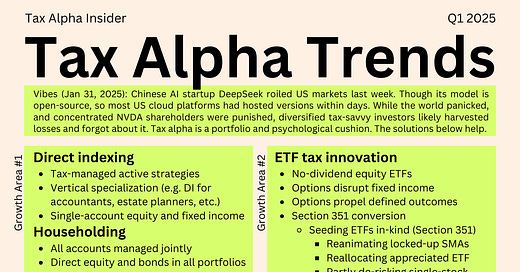Tax Alpha Trends - Q1 2025
While DeepSeek distracted everyone, diversified tax-savvy investors harvested losses and moved on. These trends in taxable wealth will make future storms easier to weather.
Heads-up: Paid subscriptions start today
Today, I’m launching a paid tier of Tax Alpha Insider.
Everyone can expect 1-2 free posts per week, including industry recaps and “tax snacks” (short examples or commentary on the latest in taxable wealth).
Paid subscribers can expect 1-2 posts per week of analysis, guides, checklists, and more.
Your subscription supports my unbiased work.
If you enjoyed my unapologetic look at covered call ETFs, or my coverage of Meb Faber launching an ETF called TAX seeded in-kind, I can do much more with your help.
If you work for a large company (many of you do!), consider a Founding Member subscription.
Thank you for reading Tax Alpha Insider.
From paid subscribers:
“tremendously useful information”
“I enjoy the research and want to know as much as I can about the tax aware space.”
“Timely, informative, objective, diligent content that's continually gets updated…”
Tax Alpha Trends
In December 2023, I posted Direct Indexing Trends.
Tax Alpha Trends takes its place and removes some of the spaghetti I threw at the wall in that earlier effort.
My goal is a simple view of the taxable investing world.
Each point in the graphic below is a little universe I could explore in a lengthy whitepaper, but that would be exhausting to produce and, more importantly, exhausting to read. So, I’ll not do that and save us both the hassle.
I expect to update Tax Alpha Trends quarterly.
The trends will change, and collecting and comparing issues over time should be fun.
I’m monitoring four growth areas in taxable wealth:
Direct indexing and its expansion into householding: Direct indexing is powerful for values personalization, risk management, tax optimization, and granular gifting. While the investing world still sells unified managed accounts, householding takes things further with holistic, asset location-aware rebalancing.
ETF tax innovation: ETFs are the bane of direct indexing. They are easy to access and explain (in concept, though the strategies are increasingly complex), well-supported in client reporting systems, allow access to a broader suite of strategies, and are, in many cases, very tax efficient (though some in the householding camp may argue otherwise). We will see more tax innovation using the ETF wrapper in 2025.
Tax-aware long/short SMAs and hedge funds: Read my primer on tax-aware long/short if you’re wondering what this is. AUM has grown to over $20 billion in just the top two sub-advisers. Investors like tax losses (capital and ordinary) despite the strategy’s complexity. While some call it a gimmick, investors are flocking to the strategy. I would not be surprised if AUM grew to $30+ billion in 2025.
Single-stock and exit planning solutions: Advisers know that tax bumps to the front of investors’ minds when they have a single-stock concentration problem or an imminent (already realized?) exit. Vendors know they must educate their clients on the nuances of each solution. Education and access will improve in 2025.
Miscellaneous categories:
Muni bond trading will get more efficient.
Transferrable renewable energy tax credits growing?
Oil & gas (and solar) active participation is powerful (not a pun).
Estate planning is mostly solved, but it could get more efficient.
Crypto keeps going up. Some want to de-risk. HODL BTC remains strong.
I am still hunting for game-changing generative AI use cases in wealth.
Shameless plug
For copyright reasons, I cannot use memes in my book about seeding an ETF in-kind. So, I’ll hand draw everything.
That means it’ll take a few more weeks, but I plan on having physical copies with me in Dallas in early March for the T3 conference.
Want a copy? Just let me know, and I’ll snail-mail you one.





